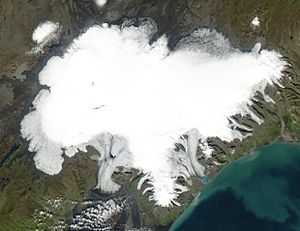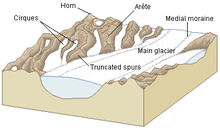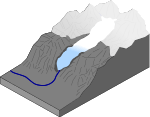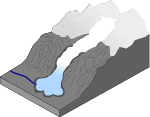Glacier morphology
Glacier morphology, or the form a glacier takes, is influenced by temperature, precipitation, topography, and other factors. Types of glaciers range from massive ice sheets, such as the Greenland ice sheet or those in Antarctica, to small cirque glaciers perched on a mountain. Glaciers types can be grouped into two main categories, based on whether ice flow is constrained by the underlying bedrock topography.
Unconstrained

Ice sheets and ice caps
Ice sheets and ice caps cover vast areas and are unconstrained by the underlying topography. The main distinction between the two is area, with ice caps covering areas less than 50,000 square kilometers, while ice sheets span larger areas.[1] Ice sheets and ice caps can be classified further.
Ice domes
Ice domes located in the accumulation zone in the higher altitude portions.
Ice streams
Ice streams rapidly channel ice flow out to the sea or ocean, where it may feed into an ice shelf. At the margin between ice and water, ice calving takes place, with icebergs breaking off. Ice streams are bounded on the sides by areas of slowly moving ice.[2]
Constrained

Icefield
An icefield covers a relatively large area, usually located in mountainous terrain. The underlying topography controls or influences the form that an icefield takes. Often, nunataks poke through the surface of icefields. Examples of icefields include the Columbia Icefield in the Canadian Rockies and the Northern and Southern Patagonian Ice Field in Chile and Argentina.
Outlet glaciers
Outlet glaciers are channels of ice that flow out of an ice sheet, but are constrained on the sides with exposed bedrock.
Valley glaciers

Valley glaciers, which provide drainage for icefields, are also constrained by underlying topography. These glaciers form up in mountain ranges as gathering snow turns to ice. Ice-free exposed bedrock and slopes often surround valley glaciers, providing snow and ice from above to accumulate on the glacier via avalanches. True fjords are formed when valley glaciers retreat and water fills the void (due to land upheaval).
Piedmont glaciers
Piedmont glaciers are valley glaciers which have spilled out onto relatively flat plains, where they spread out into bulb-like lobes.[4] The Malaspina Glacier in Alaska is the largest example of this.

Cirque glaciers


Cirque glaciers form in cirque, bowl-shaped depressions on the side of mountains. In these depressions, snow persists through summer months, and is transformed into glacier ice. Snow may be situated on the leeward slope of a mountain, where it is sheltered.
References
- ↑ "Introduction to Glaciers". National Park Service.
- ↑ McIntyre, N.F. (1985). "The Dynamics of Ice Sheet Outlets". Journal of Glaciology 31: p. 99–107. Bibcode:1985JGlac..31...99M.
- ↑ Elephant Foot Glacier at NASA Earth Obsevatory
- ↑ What types of glaciers are there? National Snow and Ice Data Center.
External links
![]() Media related to Glacial geomorphology at Wikimedia Commons
Media related to Glacial geomorphology at Wikimedia Commons
